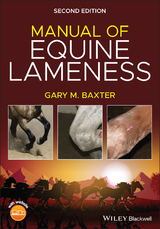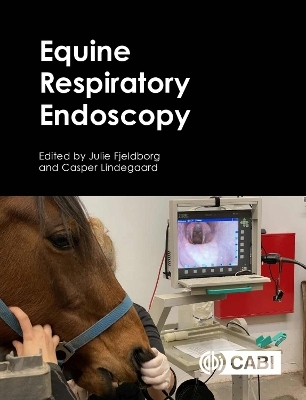
Manual of Equine Lameness
Iowa State University Press (Verlag)
978-0-8138-1546-6 (ISBN)
- Titel erscheint in neuer Auflage
- Artikel merken
Manual of Equine Lameness provides essential information on equine lameness diagnostics and treatment in an easy-to-use format ideal for the clinical setting. A clinically relevant distillation of topics from Adams and Stashak's Lameness in Horses , this text offers a quick introduction and fast access to key information. An accompanying DVD includes practical supplements, including additional anatomical images, video clips demonstrating key procedures such as perineural and intrasynovial injections, and examples of lameness conditions in motion. Designed for use in daily practice, the book is presented in brief chapters carefully formatted to maximize the usefulness for practicing veterinarians. Manual of Equine Lameness is an invaluable resource to any veterinarian treating lameness in horses and an ideal reference for veterinary students wanting to learn the fundamentals of lameness.
Gary M. Baxter , VMD, MS, is Professor Emeritus, Colorado State University and is currently the Director of the Veterinary Teaching Hospital at the College of Veterinary Medicine at the University of Georgia in Athens, Georgia.
Contributors ix Common Terminologies and Abbreviations xi Chapter 1. Functional Anatomy of the Equine Musculoskeletal System 3 Anatomic Nomenclature and Usage 3 Thoracic Limb 3 Hindlimb 32 Axial Components 56 Chapter 2. Fundamentals of Lameness Diagnosis 65 Defi nition of Lameness 65 Classifi cation of Lameness 66 What to Look For 66 Anatomic Problem Areas 75 Occupation-related Problem Areas 75 Evaluation of Foals with Lameness 76 Performing a Prepurchase Examination 78 Chapter 3. Assessment of the Lame Horse 83 History 83 Signalment and Use 83 Visual Examination at Rest 83 Palpation and Manipulation 84 Visual Exam at Exercise 107 Flexion Tests/Manipulation 108 Perineural Anesthesia 114 Intrasynovial Anesthesia 124 Chapter 4. Imaging 149 Radiography 149 Ultrasound 168 Nuclear Medicine 189 Magnetic Resonance Imaging 202 Computed Tomography 214 Chapter 5. Common Conditions of the Foot 225 Navicular Disease/Syndrome 225 Fractures of the Navicular (Distal Sesamoid) Bone 229 Injuries to the DDFT and Podotrochlear Apparatus 231 Injuries to the Collateral Ligaments (CLs) of the DIP Joint 232 Osteoarthritis (OA) of the DIP Joint 234 Fractures of the Distal Phalanx (P3, Coffin Bone) 235 Pedal Osteitis (PO) 239 Subchondral Cystic Lesions of the Distal Phalanx (P3) 240 Ossifi cation of the Collateral Cartilage of the Distal Phalanx (Sidebone) 241 Sole Bruises, Corns, and Abscesses 243 Canker 244 Thrush 245 White Line Disease 246 Penetrating Injuries of the Foot 247 Keratoma 249 Foot Imbalances 250 Club Foot 253 Toe Cracks, Quarter Cracks, Heel Cracks (Sand Cracks) 255 Laminitis 257 Chapter 6. Common Conditions of the Forelimb 267 OA of the Proximal Interphalangeal (PIP) Joint 267 Osteochondrosis (OC) of the PIP Joint 270 Luxation/Subluxation of the PIP Joint 272 Fractures of the Middle Phalanx (P2) 274 Fractures of the Proximal Phalanx (P1) 278 Desmitis of the Distal Sesamoidean Ligaments (DSLs) 283 SDFT and DDFT Injuries in the Pastern 284 Osteochondral (Chip) Fractures of Proximal P1 286 Fractures of the Proximal Sesamoid Bones 287 Sesamoiditis 291 Traumatic OA of the MCP Joint (Osselets) 293 Fetlock Subchondral Cystic Lesions (SCLs) 294 Traumatic Rupture of the Suspensory Apparatus 295 Digital Flexor Tendon Sheath (DFTS) Tenosynovitis 297 Periostitis and Fracture of the Dorsal Metacarpus (Bucked Shins, Shin Splints, and Stress Fracture) 299 MCIII/MTIII Condylar Fractures 301 Complete Fractures of the MCIII/MTIII (Cannon Bone) 303 "Splints" or Small MC Bone Exostosis 304 Fractures of the Small MC/MT (Splint) Bones 306 Suspensory Ligament (SL) Desmitis 308 Degenerative Suspensory Ligament Desmitis (DSLD) 311 Superfi cial Digital Flexor (SDF) Tendinitis (Bowed Tendon) 312 Common Digital Extensor (CDE) Tendon Rupture 314 Extensor Carpi Radialis (ECR) Tendon Damage 316 Intra-articular Carpal Fractures 317 OA of the Carpus 320 Carpal Sheath Tenosynovitis 321 Fractures of the Radius 323 Fractures of the Ulna 325 Subchondral Cystic Lesions (SCLs) of the Elbow 328 Bursitis of the Elbow (Olecranon Bursitis) 329 Fractures of the Humerus 330 Bicipital (Intertubercular Bursa) Bursitis 331 Osteochondrosis (OCD) of the Scapulohumeral (Shoulder) Joint 333 Suprascapular Nerve Injury (Sweeny) 335 Fractures of the Supraglenoid Tubercle (Tuberosity) 337 Chapter 7. Common Conditions of the Hindlimb 343 Distal Hindlimb and Foot 343 Distal Tarsal Osteoarthritis (OA) 343 Osteochondritis Dissecans (OCD) of the Tarsocrural Joint 346 Slab/Sagittal Fractures of the Central or Third Tarsal Bones 347 Fractures of the Tibial Malleoli 348 Subluxations/Luxations of the Tarsal Joints 349 Luxation of the SDFT from the Calcaneus 350 Capped Hock/Calcaneal Bursitis 352 Tarsal Sheath Tenosynovitis (Thoroughpin) 354 Rupture of the Peroneus Tertius 356 Stringhalt 357 Tibial Stress Fractures 358 Diaphyseal and Metaphyseal Tibial Fractures 359 Tibial Tuberosity/Crest Fractures 360 Fractures of the Proximal Tibial Physis 362 Femoropatellar OCD 363 Fractures of the Patella 364 Upward Fixation of the Patella (UFP) 367 Subchondral Cystic Lesions (SCLs) of the Stifle 368 Meniscal Injuries 370 Collateral/Cruciate Ligament Injury 373 Synovitis/Capsulitis/OA of the Stifl e 375 Fibrotic Myopathy 375 Diaphyseal and Metaphyseal Femoral Fractures 377 Capital Physeal Fractures of the Femoral Head 379 Coxofemoral Luxation (Dislocation of the Hip Joint) 380 OA of the Coxofemoral Joint 382 Infectious Arthritis/Physitis of the Coxofemoral Joint 383 Chapter 8. Common Conditions of the Axial Skeleton 389 Pelvic Fractures 389 Ilial Wing Fractures 390 Tuber Coxae Fractures 391 Acetabular Fractures 392 Fractures of the Sacrum and Coccygeal Vertebrae 392 Diseases of the Sacroiliac Region 393 Overriding/Impingement of Dorsal Spinous Processes 395 Supraspinous Ligament Injuries 396 Fractures of the Spinous Processes 397 Vertebral Fractures 397 Discospondylitis 398 Spondylosis 398 Facet Joint OA and Vertebral Facet Joint Syndrome 399 Nuchal Ligament Desmopathy/Nuchal Bursitis 401 Cervical Facet Joint OA 402 Chapter 9. Therapeutic Options 405 Systemic/Parenteral 405 Topical/Local 407 Intrasynovial 408 Intralesional 411 Oral/Nutritional 413 Corrective Trimming and Shoeing 417 Chapter 10. Musculoskeletal Emergencies 429 Severe Unilateral Lameness 429 Severely Swollen Limb 430 Long Bone Fractures/Luxations 432 Synovial Infections 436 Tendon Lacerations 438 Index 443
| Erscheint lt. Verlag | 15.11.2011 |
|---|---|
| Zusatzinfo | Illustrations |
| Verlagsort | Arnes, AI |
| Sprache | englisch |
| Maße | 188 x 245 mm |
| Gewicht | 1146 g |
| Einbandart | Paperback |
| Themenwelt | Veterinärmedizin ► Pferd |
| ISBN-10 | 0-8138-1546-0 / 0813815460 |
| ISBN-13 | 978-0-8138-1546-6 / 9780813815466 |
| Zustand | Neuware |
| Informationen gemäß Produktsicherheitsverordnung (GPSR) | |
| Haben Sie eine Frage zum Produkt? |
aus dem Bereich



